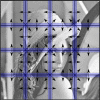Parallel ptychographic reconstruction
- PMID: 25607174
- PMCID: PMC4317139
- DOI: 10.1364/OE.22.032082
Parallel ptychographic reconstruction
Abstract
Ptychography is an imaging method whereby a coherent beam is scanned across an object, and an image is obtained by iterative phasing of the set of diffraction patterns. It is able to be used to image extended objects at a resolution limited by scattering strength of the object and detector geometry, rather than at an optics-imposed limit. As technical advances allow larger fields to be imaged, computational challenges arise for reconstructing the correspondingly larger data volumes, yet at the same time there is also a need to deliver reconstructed images immediately so that one can evaluate the next steps to take in an experiment. Here we present a parallel method for real-time ptychographic phase retrieval. It uses a hybrid parallel strategy to divide the computation between multiple graphics processing units (GPUs) and then employs novel techniques to merge sub-datasets into a single complex phase and amplitude image. Results are shown on a simulated specimen and a real dataset from an X-ray experiment conducted at a synchrotron light source.
Figures








References
-
- Born M., Wolf E., Principles of Optics: Electromagnetic Theory of Propagation, Interference and Diffraction of Light (CUP Archive, 1999).10.1017/CBO9781139644181 - DOI
Publication types
MeSH terms
Grants and funding
LinkOut - more resources
Full Text Sources
Other Literature Sources
Research Materials

